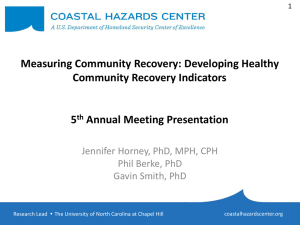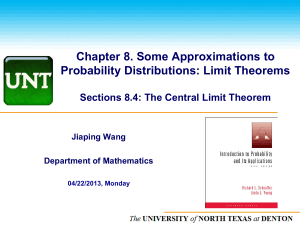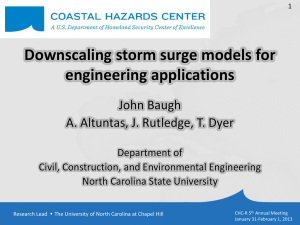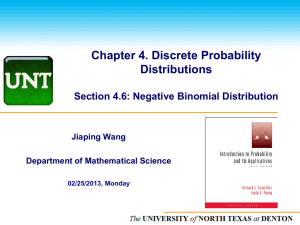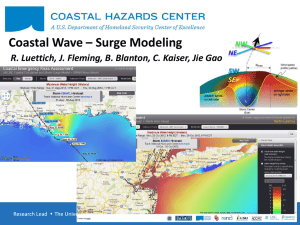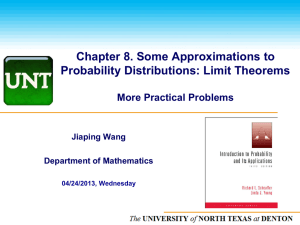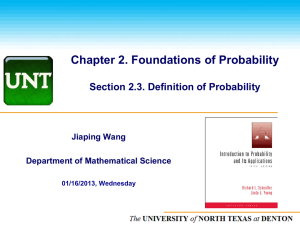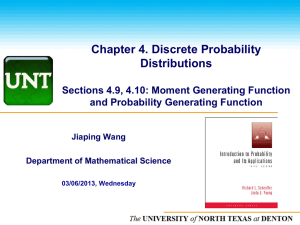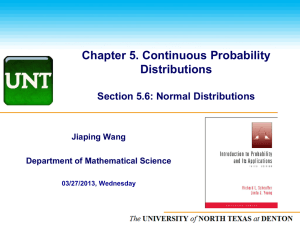by Mo Gabr, NCSU with Yulian Kebede, 2012 CHC Summer Intern
advertisement
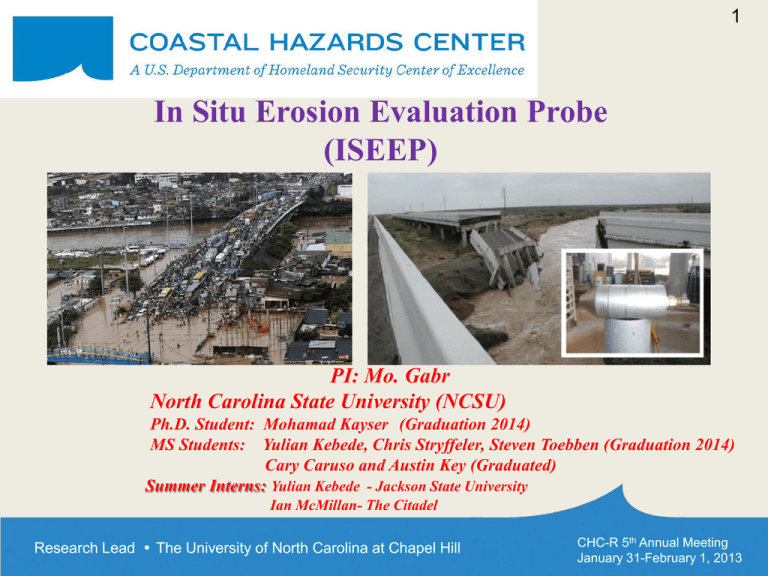
1 In Situ Erosion Evaluation Probe (ISEEP) PI: Mo. Gabr North Carolina State University (NCSU) Ph.D. Student: Mohamad Kayser (Graduation 2014) MS Students: Yulian Kebede, Chris Stryffeler, Steven Toebben (Graduation 2014) Cary Caruso and Austin Key (Graduated) Summer Interns: Yulian Kebede - Jackson State University Ian McMillan- The Citadel Research Lead The University of North Carolina at Chapel Hill CHC-R 5th Annual Meeting January 31-February 1, 2013 2 Project Overview Scope: Enhancing Capabilities for Rapid Assessment of Erosion/Scour Potential In Situ Erosion Evaluation Approach: An in situ process to assess critical erosion/scour parameters: oThreshold Stream Power oErosion Rate per unit stream power Probe (ISEEP) Motivation: What is available? Methods to measure scour potential with depth require sample removal and lab testing or only provide surface measurements Methods for rapid assessment of scourability are lacking in literature Research Lead The University of North Carolina at Chapel Hill CHC-R 5th Annual Meeting January 31-February 1, 2013 3 DHS Mission Relevance DHS Mission 5, Ensuring Resilience to Disaster: a tool to assist in fulfilling the DHS mission of infrastructure protection and hazard mitigation Rapid deployment over a large area to assess incipient erosion of soil profiles supporting protective structures with approaching storm events Rapid post storm assessment for locating temporary support infrastructures - an important aspects of emergency management State and Federal government agencies and private consultants can utilize the device data for: i. hazard mitigation, ii. enhanced preparedness, iii. effective emergency response, and iv. rapid recovery: Frequent measurement of scour potential (i, ii) Identify scour-critical structures for retrofit and action plan (i, iii) Provide data to estimate post storm stability and time-dependent stability of critical structures (iii, iv) Research Lead The University of North Carolina at Chapel Hill CHC-R 5th Annual Meeting January 31-February 1, 2013 Introduction 4 Motivation Enhancing Capabilities for Rapid Assessment of Erosion Potential of Critical Structures Bridges The Guardian, 2009 Dams and Levees Roads and Coastal Structures Research Lead The University of North Carolina at Chapel Hill CHC-R 5th Annual Meeting January 31-February 1, 2013 Existing Approaches 5 ISEEP’ Approach Ettema, R., Constantinescu, G. and Melville, B. (2011.) Research Lead The University of North Carolina at Chapel Hill CHC-R 5th Annual Meeting January 31-February 1, 2013 Existing Approaches Research Lead The University of North Carolina at Chapel Hill 6 CHC-R 5th Annual Meeting January 31-February 1, 2013 Existing Approaches 7 Richardson and Davis (2001) y 2.0 K 1 K 2 K 3 K 4 K w a a K = pier nose shape (0.9 and 1.1) ys 0 . 35 0 . 43 Fr 1 K2 = angle of attack of flow (1.0 and 5.0) K3 = state of bed-sediment motion (1.1 and 1.3) Kw = correction factor K 4 0.4 V R 0.15 VR V V icd 50 V cd 50 V icd 90 Vicdx is approach velocity required to initiate scour at the pier for grain size Dx, given by: V icdx Dx 0.645 a 0 . 053 V cdx V cdx 6.19 y 1 / 6 D 1/3 x Research Lead The University of North Carolina at Chapel Hill Fr V gy CHC-R 5th Annual Meeting January 31-February 1, 2013 Existing Approaches 8 A Better Approach? Erosion Parameters Assess • • Erosion Parameters of Soil: Critical Shear Stress Detachment Coefficient Assess Shear Stress with Time Compute Scour Magnitude and Rate Research Lead The University of North Carolina at Chapel Hill CHC-R 5th Annual Meeting January 31-February 1, 2013 9 Technical Approach: ISEEP Component Cone Tip Rod Sections Vary Flow RateMaintain Velocity Coaxial Sheathing Pump Controller Water Tank Vary VelocityMaintain Flow Rate Generator Research Lead The University of North Carolina at Chapel Hill CHC-R 5th Annual Meeting January 31-February 1, 2013 10 Field Testing Irene Breach NC-12 Temporary Bridge Wake County Bridge Research Lead The University of North Carolina at Chapel Hill CHC-R 5th Annual Meeting January 31-February 1, 2013 11 Isabel Breach Research Lead The University of North Carolina at Chapel Hill CHC-R 5th Annual Meeting January 31-February 1, 2013 12 Field Testing Kd’ and Pc GSD of NC-12 Soil 100 90 70 60 50 40 30 20 10 0 10 1 0.1 Pea Island Depth = 0-50 cm Penetration Rate (cm/s) Pea Island - Sand 80 % Passing 12 Pea Island - Organic Contents 0.01 10 Pea Island Depth = 50-200 cm 8 R² = 0.6868 6 R² = 0.9658 4 2 Pc 0 10 Grain Size (mm) Research Lead The University of North Carolina at Chapel Hill 100 1000 Stream Power (Watts/m2) 10000 CHC-R 5th Annual Meeting January 31-February 1, 2013 Field Testing and Modeling 13 Field Data Reduction 3.5 Assuming an average flow depth of 0.5 m, a 4.2 m breach is estimated to occur in approximately 1.5 hours for a 4 m/s flow velocity and in 9 hours for 3 m/s flow velocity Estimated Erosion Rate (m/hr) 3 2.5 2 1.5 Velocity = 3 m/s Velocity = 4 m/s 1 0.5 0 0 0.5 1 1.5 Depth of Flow (m) 2 Research Lead The University of North Carolina at Chapel Hill 2.5 CHC-R 5th Annual Meeting January 31-February 1, 2013 14 Modeling of Flow around Bridge Piers 1.5 m 2.5 m 1m • • • • • 3m 24 m 3m Sand Bed: 24 m long, 20 m wide and 4 m deep Layers: Two layers soil system Approach Velocity: 0.45 m/s to 0.9 m/s Depth of Flow: 1.0 m Pier Diameter: 1.22 m Research Lead The University of North Carolina at Chapel Hill CHC-R 5th Annual Meeting January 31-February 1, 2013 Pier Scour 15 3-D Scour Profile Research Lead The University of North Carolina at Chapel Hill CHC-R 5th Annual Meeting January 31-February 1, 2013 16 Bridge Scour: Empirical Equations Reference Equation Shen et al. (1969) ds = 0.000223 (Vb/υ)0.619 Breusers et al. (1977) ds /b = f(V/Vc)(2tanh(y/b))KsKtheta Jain and Fischer (1979) ds /b = 1.86(y/b)0.5(Fr – Frc)0.25 Fr = Froude number ds/b= 2KsKthetaK3K4(y/b)0.35Fr0.43 K3= factor for mode of sediment transport, K4 = factor for armoring by bed material Richardson and Davis (1995) Research Lead The University of North Carolina at Chapel Hill Comments V = flow velocity, υ = kinematic viscosity of water = 1 × 10-6 m2/s f (V/Vc) = 0, V/Vc≤0.5 =(2V/Vc-1), 0.5<V/Vc≤1 = 1, V/Vc>1 Vc = Critical velocity, Ks = shape factor, Ktheta = inclination factor CHC-R 5th Annual Meeting January 31-February 1, 2013 17 Scour Depth / Pier Diameter Bridge Scour: Empirical Equations 1.8 1.5 ISEEP 1.2 FLOW-3D 0.9 Shen et al. (1969) 0.6 Jain and Fischer (1979) 0.3 Richardson and Davis (1995) 0 0 200 400 600 800 Stream Power (Watt/m2) Research Lead The University of North Carolina at Chapel Hill 1000 CHC-R 5th Annual Meeting January 31-February 1, 2013 18 Laboratory Experiments & Field Testing Yulian A. Kebede Research Lead The University of North Carolina at Chapel Hill CHC-R 5th Annual Meeting January 31-February 1, 2013 19 Lab Testing with Clay-Sand Mixture Dry weight of mixture: 10% Fines - 90 % sand Initial water content : 18 % - 23 % Dry unit weight (kN/m3) Mean Undrained Particle Shear Diameter, Strength, d50 (mm) Cu (kPa) 17.7 Research Lead The University of North Carolina at Chapel Hill 0.26 5-8 Liquid Plasticity Limit, Index, PI LL 20 0 CHC-R 5th Annual Meeting January 31-February 1, 2013 20 Penetration rate (cm/s) Lab Testing Results • 3.5 3 2.5 2 1.5 1 0.5 0 Run time = 15s Run time = 30s Run time = 45s Run time = 60s 10 100 Stream Power (Watts/m2) kd 0.017 cm/sec per N/m2 (45 sec) 0.015 cm/sec per N/m2 (60 sec) • Pc 16 Watts/m2 • Vc 0.32 m/s • tc 1.75 Pa Research Lead The University of North Carolina at Chapel Hill CHC-R 5th Annual Meeting January 31-February 1, 2013 21 • Flow Velocity range of 1.0 m/s to 2.0 m/s (Froude number 0.23 to 0.45) • Pier Diameter = 1 m • Depth of flow = 2 m Ansari et al. (2002) dsmc/dsms = 1.51(C*/φ*)0.2 Research Lead The University of North Carolina at Chapel Hill CHC-R 5th Annual Meeting January 31-February 1, 2013 22 ERDC Collaboration: Lake Calumet Testing • Located at far south side of Chicago, IL • Largest body of water in the city • Highly contaminated due to years of industrial waste and runoff from nearby land fills • Contains an approximate water depth of 4 ft with a clay layer located about 1cm beneath the water depth Research Lead The University of North Carolina at Chapel Hill CHC-R 5th Annual Meeting January 31-February 1, 2013 23 Plan • Collaboration with ERDC in effort to compare and contrast results with that of the Erosion Function Apparatus (EFA) – EFA testing lead by Dr. Joseph Gialani • Scheduled to take place in March/April • ISEEP testing will be performed onsite and the EFA testing will collect sample and perform testing in a nearby testing facility Research Lead The University of North Carolina at Chapel Hill CHC-R 5th Annual Meeting January 31-February 1, 2013 24 Next Steps Validation Modeling of Various Hydraulic Structures resting on soils with fine contents and Storm Conditions Incorporation of skin friction factor to the data reduction scheme especially at greater penetration depths. Extend the collaboration work from the lab to the field by performing field tests at sites where scour rates have been established in the past Process the testing approach and the data reduction scheme for acceptance as ASTM standards Research Lead The University of North Carolina at Chapel Hill CHC-R 5th Annual Meeting January 31-February 1, 2013 25 Milestones Modeling of various types of hydraulic structures resting and assessing applicability of ISEEP for assessment of scour magnitude Viability of the approach in various types of soils, including soil with fine contents The refinement of the data reduction scheme with incorporation of factors such as the rods’ skin resistance especially at greater penetration depths Applicability of the results in view of other existing approaches that require soil sampling Research Lead The University of North Carolina at Chapel Hill CHC-R 5th Annual Meeting January 31-February 1, 2013 26 End Users and Translation Activities Federal Emergency Management Agency (FEMA) U.S. Army Corps of Engineers (USACE) State Offices and Agencies of Emergency Management State Offices of Dam Safety Standardization of the testing process and data reduction scheme , and submission to Committee D18.02 on “Sampling and Related Field Testing for Soil Evaluations” for review and commenting. The system is available now and the plan is to test it in cooperation with ERDC CHL as outlined in the proposal. Transition of ISEEP to government and private sector via commercialization processes –Discussion on incubator for a private company, North Carolina State University office of Technology Transfer. Research Lead The University of North Carolina at Chapel Hill CHC-R 5th Annual Meeting January 31-February 1, 2013 27 Products Media Publicity Gizmag, November 2010 “Safer levees and bridges thanks to new erosion and scour detector” ASCE Civil Engineering Magazine, August 2011-Technology Section, Page 40 “Probe Reveals Hidden Potential of Scour,” Conference Proceedings Cary Caruso and M. A. Gabr (2010)“In Situ measurement of the scour potential of non-cohesive sediments (ISEP)” Geotechnical Special Publication No. 211, American Society of Civil Engineers (ASCE), pp. 115-125. Cary Caruso and M. A. Gabr (2011) “In Situ Assessment of Scour Potential with Depth Using Jetting Approach,” Geotechnical Special Publication No. 211, (ASCE), pp.1483-1492. M. Kayser and M. A. Gabr (2013). “Scour assessment in cohesive soil using ISEEP.” Accepted, International Conference on Soil Mechanics and Geotechnical Engineering, Paris, France, 2013. Posters Caruso, C. W., Poster Presentation at DIEM meeting with DHS Under Secretary of S&T , Chapel Hill, NC, Feb 2011. Caruso, C. W, DHS University Summit Student Day, Washington, DC, Mar., 2011. Kayser, M. and Gabr, M. “Scour Assessment of Bridge Foundations Using an In Situ Erosion Evaluation Probe (ISEEP)” 92nd Transportation Research Board meeting, Washington DC, January 2013. Journal Papers Gabr, M. A., Caruso, C. W., Key, A., and Kayser, M. “Assessment of In Situ Scour Profile in Sand using a Jet Probe,”, Journal paper accepted by ASTM, Geotechnical Testing, in press. Kayser, M. and Gabr, M. A. “Scour Assessment of Bridge Foundation Using In Situ Erosion Evaluation Probe (ISEEP).” Journal paper accepted by the Journal of the Transportation Research Board, in press. Masters Thesis and Masters Project Cary Caruso “In Situ Measurement of the Scour Potential of non-cohesive Sediments “ MS thesis, August , 2011 Austin Key “ Data Reduction Protocol for Assessment of Erosion Parameters Using ISEP ,” MCE Project. January 2012 Research Lead The University of North Carolina at Chapel Hill CHC-R 5th Annual Meeting January 31-February 1, 2013 28 Thank You Questions? Research Lead The University of North Carolina at Chapel Hill CHC-R 5th Annual Meeting January 31-February 1, 2013
